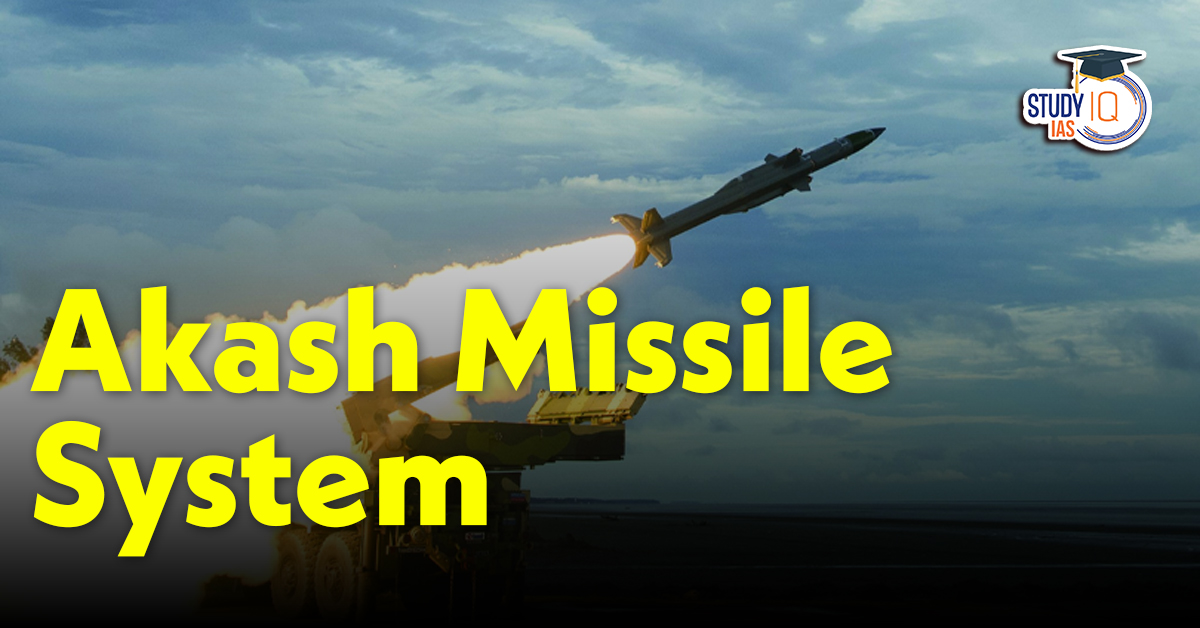Table of Contents
Akash Missile System played an important role in Operation Sindoor by successfully neutralising air-borne threats initiated by Pakistan. It is a vital part and the “backbone” of India’s multi-layered air defence system during the operation Sindoor. India’s top surface-to-air missiles — S400 Triumf, Barak 8 MRSAM (Medium Range Surface to Air Missile) and indigenous Akash Air Defence Missile System— were central to it as the IAF engaged its Integrated Counter UAS (Unmanned Aerial Systems) Grid and other air defence systems to counter the Pakistan attacks. Check here all about the Akash Missile System, its Key Features and variants in detail.
Akash Missile System
The Akash Missile System is a short-to-medium-range surface-to-air missile (SAM) system that has been indigenously developed to defend weak points and assets against aerial attacks in the form of fighter aircraft, cruise missiles, and drones. Designed by India’s Defence Research and Development Organisation (DRDO) and manufactured by Bharat Dynamics Limited (BDL) and Bharat Electronics Limited (BEL), it is one of the main parts of India’s multi-layered air defence system.
The Akash system was developed over 15 years by former DRDO scientist Dr Prahlada Ramarao. Now 78, he was the youngest Project Director for the Akash programme when he was personally selected by India’s ‘missile man’ and former President Dr APJ Abdul Kalam. The Akash system was sold to Armenia in a Rs 6,000-crore deal.
Role of Akash Missile System in Operation Sindoor
In the recent conflict with Pakistan, the Indian Defence Forces have used the Akash missile system to shoot down and destroy several airborne threats, such as drones and missiles. On the night of May 8–9, 2025, particularly, the Indian Army and Air Defence successfully defended against Pakistani drone intrusions along the western border and the Line of Control (LoC) in Jammu and Kashmir.
Key Features of Akash Air Defence Missile System
| Features | Details |
| Range | 4.5 km to 25-30 km. The Akash-NG version increases this to 70-80 km. |
| Altitude | Can target targets from 100 meters to 18-20 km. |
| Speed | Mach 2.5 to 3.5 (to 4,200 km/h). |
| Warhead | Carries a 60 kg high-explosive, pre-fragmented warhead (conventional or nuclear tipped) |
| Guidance | Command guidance with digital autopilot, using the Rajendra Passive Electronically Scanned Array (PESA) 3D radar for target tracking and engagement. |
| Mobility | The whole system is carried on mobile mountings (tracked and wheeled), permitting quick deployment. |
| Multi-Target Engagement | Able to track 64 targets and engage two targets at once (up to 12 per battery). |
| Electronic Counter-Counter Measures (ECCM) | Designed to withstand jamming and function well in hostile electronic warfare environments. |
| High Kill Probability | 88% for a single missile, up to 99% for a salvo of two. |
Variants of Akash Missile System
Akash Mk-1
- Akash Mk-1 is the original variant of the Akash missile system.
- It has a range of operation of 25-30 km.
- It can target altitudes between 100 meters and 18-20 km.
- It employs command guidance with a digital autopilot and is dependent on Rajendra Passive Electronically Scanned Array (PESA) 3D radar for target tracking and firing.
- It’s in use with the Indian Army as well as the Indian Air Force.
Akash-1S
- Akash-1S is a more advanced version of the original Akash missile.
- The major enhancement is the incorporation of an indigenous seeker.
- This new seeker technology offers greater accuracy and is thus superior in combating smaller and more agile aerial targets such as cruise missiles and UAVs.
- It maintains an equal range of approximately 25-30 km.
- India is also selling this strain, with Armenia becoming the initial foreign customer.
Akash Prime
- Akash Prime is a newer variant than the Akash Mk-1 and Akash-1S.
- It has a refined active Radio Frequency (RF) seeker, and this results in even greater precision in striking aerial targets.
- It is particularly engineered for consistent performance in cold conditions at higher elevations.
- The Akash Prime also features an upgraded ground system from the previous versions.
- Though the precise range parameters are sometimes different in reports, it is often reported to possess a comparable range to the previous Akash variants (approximately 25-30 km), though some sources estimate a slightly increased range.
Akash-NG (Next Generation)
- Akash-NG (Next Generation) is the most recent model, which is currently being developed and tested.
- It has important advancements over its past models, with a longer range of 70-80 km.
- The missile’s design is now lighter in weight and comes equipped with canisterized launchers for increased mobility and storage space.
- One significant improvement is the addition of an active electronically scanned array (AESA) Multi-Function Radar (MFR), which offers greater accuracy and better performance against next-generation threats such as stealth planes and high-speed missiles.
- Akash-NG also has a faster reaction time and increased resistance to saturation attacks.
- It employs a dual-pulse solid rocket motor in the second stage, hence, it is lighter.
- It is expected to come into service by approximately 2026.
Conclusion
Akash missile system, the indigenously made surface-to-air missile (SAM) of India, has recently shown its operational acumen in both combat operations and military exercises. The Akash system, with its recent reported success against Pakistani drones and missiles during the ongoing tensions, highlights India’s increased self-reliance in cutting-edge military technology as well as its strategic significance in regional air defences.


 Advanced Air Defence Radars: Types, Comp...
Advanced Air Defence Radars: Types, Comp...
 Ion Chromatography, Working and Applicat...
Ion Chromatography, Working and Applicat...
 Broadly Neutralising Antibodies (bNAbs):...
Broadly Neutralising Antibodies (bNAbs):...

























